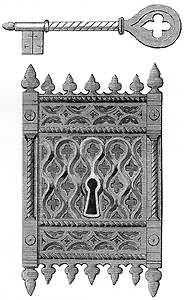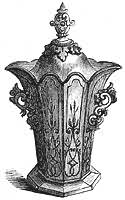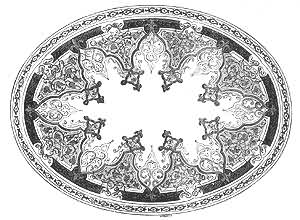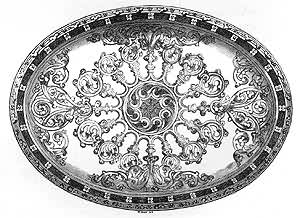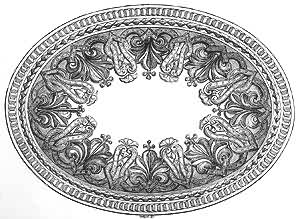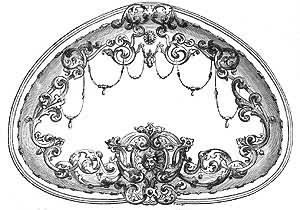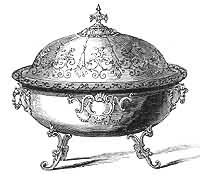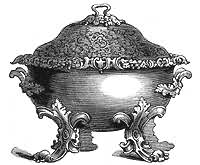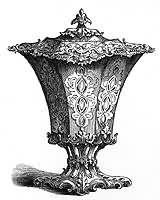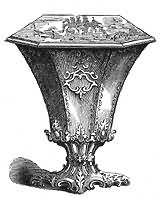Wolverhampton at the Great Exhibition, 1851A note by Frank Sharman I expect that a place like Wolverhampton had many exhibitors at the Crystal Palace. I presume you could find out about them by looking in the original documents relating to the Great Exhibition, which are probably in the PRO. Another way of going about it might be from this end, checking what is in the local archives, particularly the local newspapers. But I have a copy of the Art Journal Illustrated Catalogue of the Industry of All Nations, published by Virtues for the Art Journal, in 1851. This is by no means a complete catalogue of all the exhibits at the Great Exhibition, but it selects and illustrates some of them - the selection being made by the staff of the Art Journal. Their selection probably reflects goods which they thought were artistic rather than goods which they thought of unadorned practical use. So far as I can see, Wolverhampton is represented in this catalogue as follows. The text is transcribed from, and the engravings scanned (and reduced in size) from, the catalogue; the layout is not reproduced but it seems to make as much sense as in the original.
Page 32: The three coal-vases, or, as such articles of domestic use are generally called, coal-scuttles, are from the establishment of Mr. Perry, of Wolverhampton, who has, with much good taste, endeavoured to give a character of elegance to these ordinary but necessary appendages to our "household hearths". Hitherto, in whatever room of a dwelling-house one happens to enter the coal-scuttle is invariably thrust into some obscure corner, as unworthy of filling a place among the furniture of the apartment, and this not because it is seldom in requisition, but on account of its unsightliness. Mr. Perry's artistic-looking designs, though manufactured only in japanned iron, may, however, have the effect of drawing them from their obscurity, and assigning them an honourable post, even in the drawing-room. It is upon such comparatively trivial matters that art has the power to confer dignity; and notwithstanding the absurdity - as we have sometimes heard it remarked - of adopting Greek and Roman models in things of little importance, they acquire value from the very circumstance of such pure models having been followed.
Page 98: The town of Wolverhampton is a formidable rival to Birmingham in the extent of its manufactures in papier-mâché, and it slight iron-ware productions of every kind. It is almost impossible to enumerate the variety of articles included in this category; but we may in particular, allude to tea-trays of very description, coal-vases, candlesticks, bread-baskets, ornamental baskets, &c. &c. The business transactions in these and similar manufactures are most extensive, both for the home market and for exportation. Messrs. Walton & Co., of Wolverhampton, are among its chief manufacturers, and, consequently, their contributions to the Great Exhibition are on a proportionate scale of magnitude and importance, including a large variety of trays, sundry vases, tazzi, coal-scoops, dish-covers, &c. On this and the following columns we engrave six subjects - a Tazza, a Coal-vase, and four trays, all, excepting the second, made of papier-mâché. The tazza is decorated with Roman ornaments in gold and colours; the coal-vase is also ornamented with the same materials. The trays show the several styles of Byzantine, the German Gothic, the Renaissance, the Alhambresque, and the Elizabethan, worked in gold, pearls, and colours. Many of the manufactures contributed by Messrs. Walton are painted with much taste and elegance, as representations of landscape, and historical and fancy scenes. The perfect adhesion of an opaque glass fused by heat on the surface of the wrought iron, so as to produce a smooth and even enamel, capable of withstanding the effects of the atmosphere, has long been considered a great desideratum by all manufacturers of hardware; this object Messrs. Walton & Co seem to have successfully attained. The articles shown are covered with two kinds of enamel; that intended for better purposes is of a pure white colour, that upon more common articles is black, and is applied to coat the articles both inside and out. It is less expensive, and is equally effective and durable: the contributions of the firm are very attractive.
Page 110: The four engravings which occupy these two columns represent coal-boxes, to use the only term that seems applicable to their purpose, although it is inappropriate, when the form of these objects is regarded; they are manufactured in japanned iron by Mr. H. Fearncombe, of Wolverhampton.
|
